Your cart is currently empty!
Category: Home and Property
How to Remodel Your Home on Any Budget
You can tackle home remodeling on any budget by setting clear priorities and making smart choices. Start with a detailed plan that separates must-haves from nice-to-haves, and allocate 20% for unexpected issues. Save money through DIY demo work, shopping sales, and choosing mid-grade materials strategically. Focus on high-impact, low-cost updates like paint and hardware when funds are tight. With the right approach, you'll discover countless ways to transform your space affordably.
Setting Realistic Goals and Planning Your Budget
Before diving into any home remodeling project, you'll need to establish clear goals and create a detailed budget that matches your financial reality. Start by listing your must-have improvements and separating them from your nice-to-have wishes. Research average costs for materials and labor in your area to set reasonable expectations.
Once you've identified your priorities, determine your funding sources. Will you use savings, a home equity loan, or a renovation credit card? Don't forget to set aside 20% of your total budget for unexpected issues that often arise during remodeling. Break down your budget into specific categories like demolition, materials, labor, permits, and finishing touches. Consider timing your project strategically – you'll often find better deals on materials and contractor availability during off-peak seasons.
Smart Ways to Save Money During Renovations
With your budget and goals established, you can maximize your renovation dollars through strategic money-saving techniques. Consider both short-term savings and long-term value when making decisions about materials, labor, and timing.
- Compare prices across multiple suppliers and wait for seasonal sales on major appliances and materials
- Handle simple demolition work yourself instead of paying contractors
- Keep existing plumbing and electrical layouts to avoid costly relocations
- Choose mid-grade materials for high-impact areas and budget-friendly options for less visible spaces
- Buy slightly imperfect or overstock items that still meet quality standards
These smart choices help stretch your renovation budget without compromising on quality. Remember to maintain a contingency fund for unexpected issues and prioritize improvements that add lasting value to your home.
Low-Cost Updates That Make a Big Impact
Several impactful home updates don't require breaking the bank or extensive renovations. You can transform your space by painting walls, cabinet fronts, or dated tile for an instant refresh. Swapping out hardware on cabinets, doors, and drawers creates a modern look for minimal cost. Installing new light fixtures or updating existing ones with spray paint can brighten any room dramatically.
Consider adding peel-and-stick backsplash tiles or wallpaper for texture and visual interest. Replace dated switch plates, outlet covers, and doorknobs for a cohesive appearance. Add crown molding or upgrade baseboards to enhance architectural detail. Fresh caulk around sinks, tubs, and windows instantly improves appearance while preventing water damage. Even simple updates like new shower curtains, window treatments, or area rugs can dramatically change your home's look without major expenses.
Where to Splurge vs. Where to Save
Making smart decisions about where to invest your remodeling budget can greatly impact both your home's value and your daily comfort. When planning your renovation, prioritize spending on permanent fixtures and essential systems while saving on elements you can easily update later.
- Splurge on kitchen countertops, cabinets, and high-quality appliances – they're used daily and markedly affect resale value
- Save on decorative items, cabinet hardware, and light fixtures that you can upgrade over time
- Invest in quality bathroom plumbing fixtures and waterproofing to prevent costly repairs
- Choose mid-range flooring for bedrooms and living spaces, but splurge on high-traffic areas
- Save on paint and wallpaper since they're relatively inexpensive to change, but don't skimp on surface preparation
DIY Projects vs. Hiring Professionals
Deciding when to tackle a renovation project yourself versus hiring a professional can greatly impact your budget and results. You'll want to DIY projects that require basic skills, like painting, installing baseboards, or updating cabinet hardware. These tasks can save you significant money while allowing you to learn valuable home improvement skills.
However, you should hire professionals for projects involving electrical work, plumbing, structural changes, or complex installations. These jobs often require permits, specialized tools, and technical expertise. A mistake in these areas could be costly or dangerous. When hiring contractors, get multiple bids, check references, and verify licenses and insurance. Remember that while DIY can save money upfront, a professional's expertise might prevent expensive mistakes and guarantee your renovation meets local building codes.
Financing Options for Home Remodeling Projects
Whether you choose to DIY or hire professionals, funding your home remodel requires careful financial planning. You'll need to evaluate various financing options based on your credit score, home equity, and monthly budget.
Common financing methods for home renovations include:
- Home equity loans or HELOCs, which use your house as collateral
- Personal loans from banks or credit unions for smaller projects
- Credit cards with 0% APR introductory periods for short-term financing
- Cash-out refinancing to access equity while potentially lowering interest rates
- Government-backed renovation loans like FHA 203(k) or HomeStyle
Consider the interest rates, repayment terms, and potential tax implications of each option. For major renovations, you might combine multiple financing sources. Remember to maintain an emergency fund separate from your renovation budget to handle unexpected costs during the project.
Conclusion
You don't need a massive budget to transform your living space – it's all about making smart choices and prioritizing your projects. Whether you're doing a complete overhaul or making small updates, remember to set realistic goals, research cost-saving opportunities, and choose where to invest versus where to save. With careful planning and the right approach, you'll create the home of your dreams within your means.
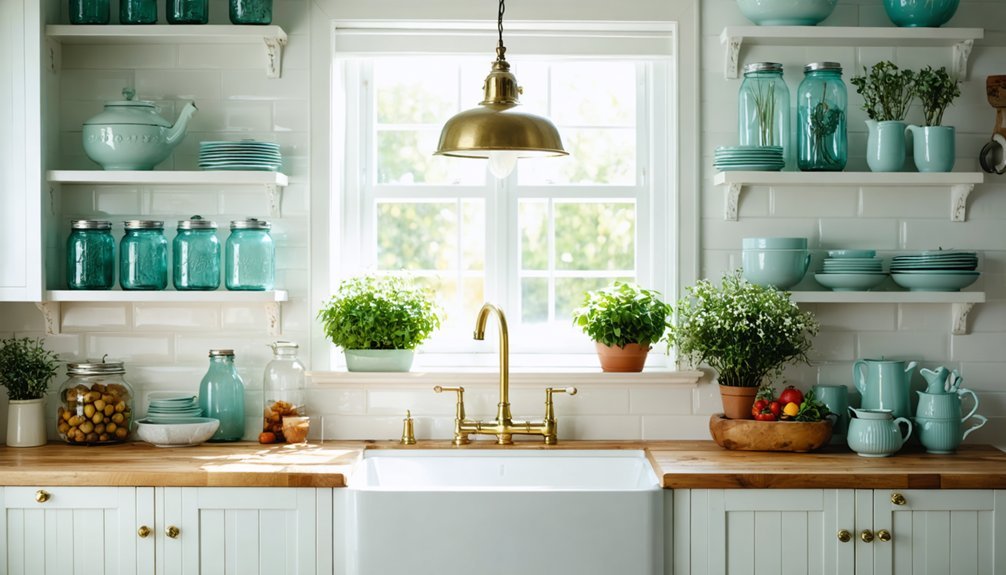
Kitchen Remodeling on a Budget: 10 Money-Wise Solutions
Transform your kitchen without breaking the bank by focusing on high-impact, low-cost upgrades. You'll see dramatic results from a fresh coat of paint, new cabinet hardware, and strategic lighting improvements. Consider affordable alternatives like laminate countertops, vinyl flooring, and DIY backsplash solutions. Don't forget practical enhancements like rolling carts and second-hand appliances. These budget-friendly solutions will help you create the kitchen you've always wanted – and there's even more to discover.
Paint Your Way to a Fresh Look
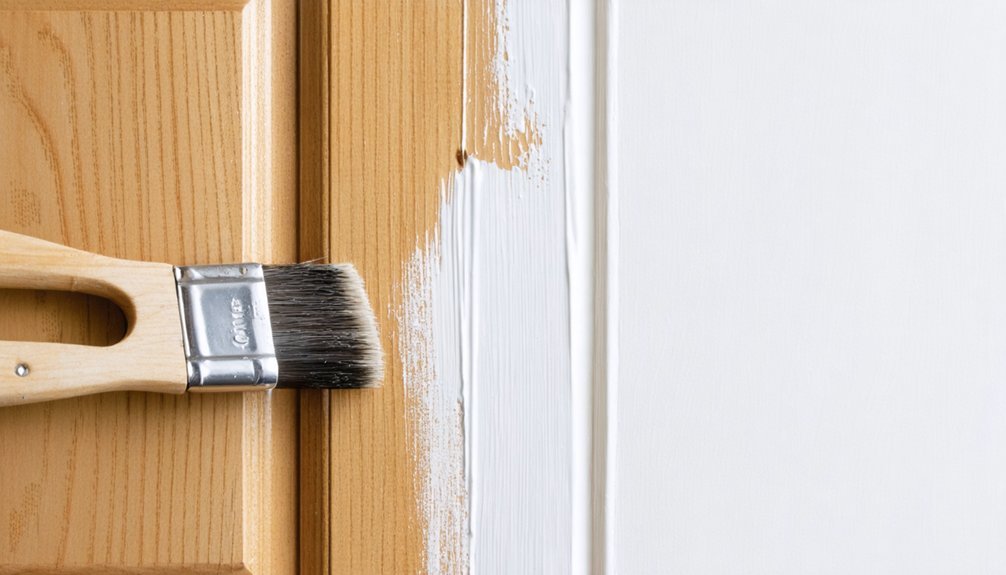
While a full kitchen renovation can cost tens of thousands, a fresh coat of paint offers dramatic results for just a few hundred dollars. You'll need to invest in quality paint, brushes, rollers, and primer to guarantee a professional finish. Start by thoroughly cleaning all surfaces and repairing any holes or cracks in the walls.
Don't limit yourself to just the walls – consider painting your cabinets, too. Modern cabinet paint formulas are durable and resist chipping. Choose light colors to make your space feel larger, or go bold with trendy two-tone combinations. You can transform dated oak cabinets into crisp white ones or give your walls a modern gray makeover. Just remember to use kitchen-specific paint that resists moisture, grease, and frequent cleaning.
Cabinet Hardware Updates and Refinishing
After revitalizing your kitchen with paint, upgrading your cabinet hardware can complete the transformation. Swap out dated knobs and pulls for modern alternatives in finishes like brushed nickel, matte black, or antique brass. You'll find affordable options at home improvement stores and online retailers for $2-5 per piece.
If your cabinets look worn, consider refinishing them instead of replacing them. Start by removing the doors and hardware, then thoroughly clean all surfaces. Sand the wood lightly, and apply a deglosser to help the new finish adhere. Choose between paint, stain, or a cabinet refinishing kit. Work in thin layers, allowing proper drying time between coats. Finally, seal your work with a clear protective finish to guarantee durability and a professional look.
Strategic Lighting Makeover
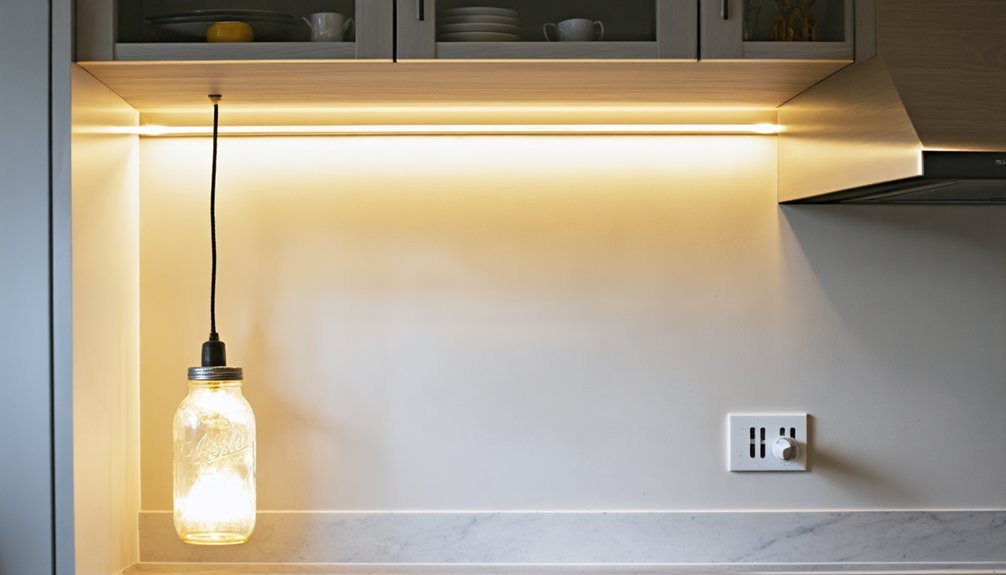
Since lighting dramatically impacts both functionality and mood, upgrading your kitchen's illumination can create significant changes without breaking the bank. Install LED under-cabinet lights to brighten work areas and create ambiance – they're energy-efficient and easy to mount yourself. Replace outdated fixtures with modern pendant lights over islands or dining areas, and consider installing dimmer switches for flexible lighting control.
Don't forget to maximize natural light by removing heavy window treatments or replacing them with sheer options. For dark corners, add battery-operated puck lights or affordable stick-on LED strips. If you've got recessed lighting, simply upgrading to new LED bulbs can improve brightness while reducing energy costs. These lighting improvements offer high impact for relatively low investment, transforming your kitchen's look and functionality.
Budget-Friendly Countertop Alternatives
Several attractive countertop alternatives can give you an upscale look without the premium price tag of granite or quartz. Consider butcher block for a warm, natural appearance that's both functional and timeless. Laminate has evolved dramatically, now offering realistic stone and wood patterns at a fraction of the cost.
Concrete countertops provide a modern, industrial feel and you can DIY them with proper research and preparation. For a sleek finish, try ceramic tile with minimal grout lines or opt for large-format porcelain slabs. Don't overlook refinishing kits for existing countertops – they can transform worn surfaces into faux stone finishes for under $100.
These budget-conscious options will modernize your kitchen while keeping your wallet intact, and many can be installed without professional help.
DIY Backsplash Solutions
A backsplash transformation doesn't require professional installation or expensive materials. You'll find several budget-friendly options that can dramatically change your kitchen's look.
Peel-and-stick tiles offer the fastest solution, coming in various styles from subway patterns to mosaic designs. They're easy to cut, apply, and remove if you decide to update later. Paint-resistant wallpaper specifically designed for kitchens provides another quick fix, while stencils and paint can create custom patterns for under $50.
For a more traditional approach, you can install ceramic tiles yourself using SimpleMat adhesive instead of mortar. Consider using tin ceiling tiles, beadboard panels, or even laminate flooring pieces as creative backsplash materials. Smart planning and basic DIY skills will help you achieve professional-looking results without breaking your budget.
Affordable Flooring Options
Moving from wall to floor improvements, your kitchen's foundation can make a remarkable visual impact without draining your savings. You'll find several budget-friendly options that combine durability with style.
Material Cost/sq.ft Durability Vinyl Planks $2-5 10-20 years Laminate $1-3 15-25 years Peel-and-Stick $1-2 5-10 years Cork $3-8 20-30 years Painted Concrete $2-4 15+ years Don't overlook vinyl planks, which offer water resistance and easy installation. Laminate flooring provides excellent durability at a fraction of hardwood's cost. For the ultimate DIY solution, peel-and-stick tiles can transform your space in a weekend. Cork offers natural comfort and soundproofing, while painted concrete turns your existing floor into a custom canvas.
Open Shelving and Storage Hacks
While traditional cabinets can strain your budget, open shelving offers a stylish and cost-effective alternative that instantly modernizes your kitchen. You'll spend a fraction of the cost on sturdy floating shelves compared to custom cabinetry, and they're easier to install yourself.
Make the most of your open shelving by using matching glass containers for dry goods, coordinated baskets for produce, and sleek hooks underneath for hanging mugs or utensils. Don't forget to maximize vertical space with stacked shelving units or tension rods for storing cutting boards and baking sheets.
For additional storage, consider mounting a magnetic knife strip, installing a pegboard wall system, or adding under-sink organizers. These affordable solutions help you stay organized while creating an airy, spacious feel that makes your kitchen more inviting.
Second-Hand Appliance Shopping Tips
Second-hand appliances can slash your renovation costs by 40-60% while still delivering reliable performance. When shopping for pre-owned kitchen equipment, focus on reliable brands and carefully inspect each item's condition before purchasing.
Look for appliances at these trusted sources:
- Local appliance dealers who offer refurbished units with warranties
- Estate sales and auctions, where you'll often find high-end items at steep discounts
- Reputable online marketplaces that specialize in certified pre-owned appliances
Don't forget to check the appliance's age, energy efficiency rating, and service history. Test all functions during inspection and ask about return policies. You'll want to factor in delivery costs and potential repair needs when calculating total savings. Consider hiring a professional appliance inspector for expensive items like refrigerators or ranges to guarantee you're making a sound investment.
Space-Saving Layout Modifications
Even in a small kitchen, strategic layout modifications can maximize your functional space without requiring costly expansions. You'll find that simple changes to your kitchen's layout can create better workflow and storage opportunities.
Space-Saving Solution Benefit Corner carousel units Transforms dead corners into accessible storage Vertical cabinet stacking Utilizes ceiling height for extra storage Pull-out pantry shelves Makes deep cabinets fully accessible Door-mounted organizers Creates storage on cabinet interiors Magnetic knife strips Frees up counter and drawer space Consider removing bulky soffits to extend cabinets to the ceiling, or install a pot rack to free up cabinet space. If you're working with a galley kitchen, adding a rolling cart creates a mobile prep station that you can tuck away when not in use.
Cost-Effective Sink and Faucet Upgrades
Upgrading your sink and faucet can dramatically improve your kitchen's functionality without breaking the bank. Consider replacing your old fixtures with mid-range stainless steel options that offer durability and style at reasonable prices. You'll find quality sinks at home improvement stores for $200-300, while reliable faucets typically range from $100-150.
To maximize your investment, focus on these practical upgrades:
- Install a deeper single-basin sink instead of a divided one – it's more versatile and usually costs less
- Choose a pull-down faucet with multiple spray settings for enhanced functionality
- Add a soap dispenser into an existing hole to eliminate counter clutter
Don't forget to check clearance sections and holiday sales for additional savings. If you're handy, you can save substantially by handling the installation yourself.
Conclusion
You don't need to break the bank to transform your kitchen into a space you'll love. By combining these budget-friendly solutions with careful planning and some DIY effort, you can create a stunning kitchen makeover that fits your financial goals. Whether you're painting cabinets, installing new hardware, or hunting for deals on appliances, these smart renovations will give you the most value for your investment.
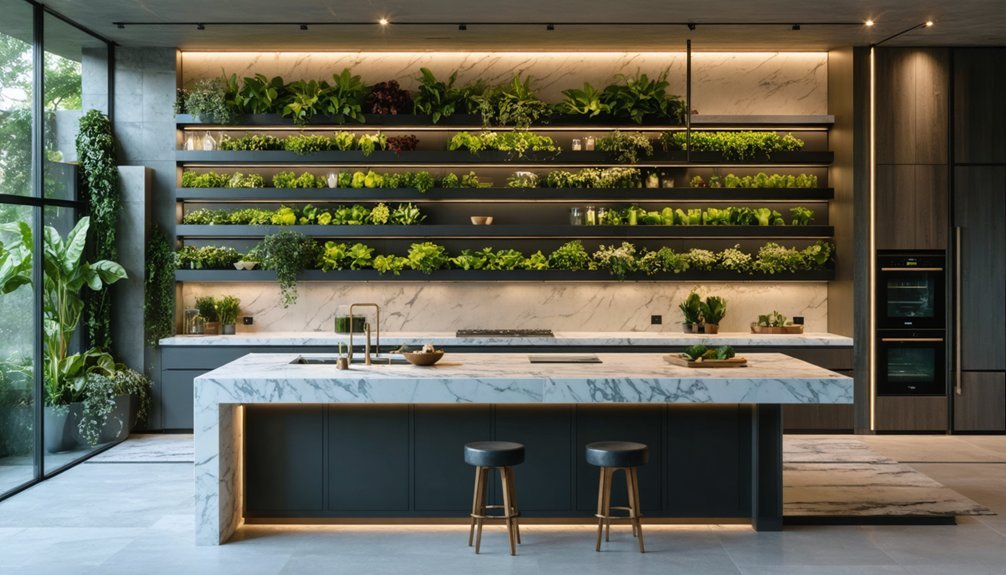
Kitchen Remodel: Top 7 Design Trends for 2025
Your 2025 kitchen remodel will blend cutting-edge AI technology with eco-conscious design. You'll enjoy smart appliances that track groceries and suggest recipes, while sustainable materials like recycled glass countertops and bamboo cabinetry reduce your environmental impact. Expect minimalist open shelving, biophilic elements with living herb walls, and multi-functional islands that double as workspaces. From touchless features to bold statement surfaces, these innovative trends will transform your kitchen into a future-forward hub. Let's explore each trend's game-changing potential.
Smart Appliances and AI-Powered Kitchen Systems
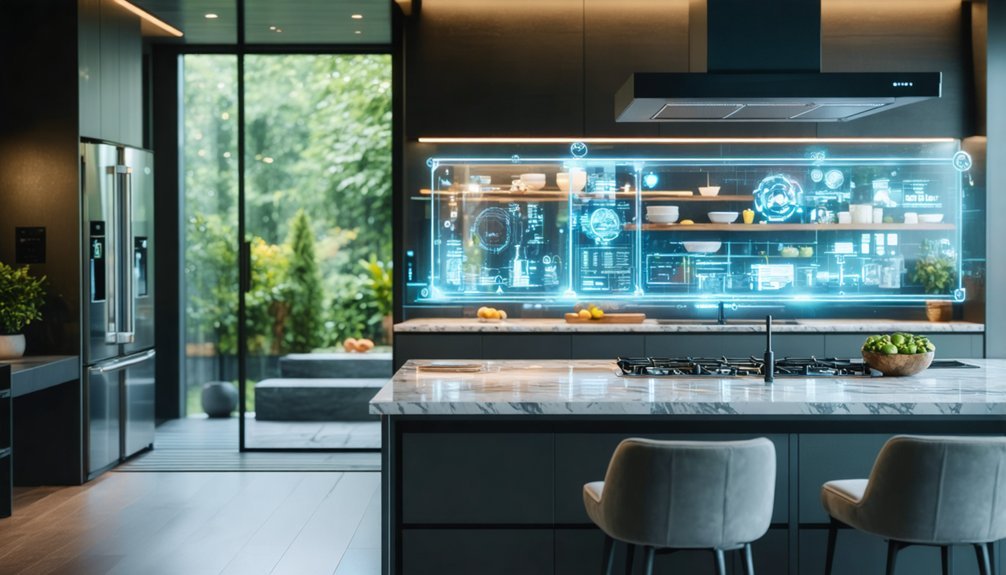
As homeowners embrace the digital revolution, smart appliances and AI-powered systems are transforming modern kitchens into high-tech culinary hubs. You'll find refrigerators that track your groceries and suggest recipes based on available ingredients, while smart ovens adjust cooking temperatures and times automatically through app control.
Voice-activated faucets, lighting, and appliances let you multitask efficiently, keeping your hands free while cooking. AI-powered waste management systems help sort recyclables and monitor food freshness, reducing waste. Smart dishwashers optimize water usage and select the perfect cycle for your dishes.
The integration of these technologies isn't just about convenience – it's about creating a more sustainable and efficient kitchen. Connected appliances can monitor energy usage, suggest power-saving modes, and even schedule maintenance before problems occur.
Sustainable Materials and Zero-Waste Design
While traditional kitchen designs often prioritized aesthetics over environmental impact, sustainable materials and zero-waste features now dominate 2025's remodeling trends. You'll find eco-friendly countertops made from recycled glass, bamboo cabinetry, and cork flooring taking center stage. Built-in composting systems and sorting stations make waste management effortless.
Material Environmental Benefit Recycled Glass Reduces landfill waste Bamboo Fast-growing, renewable Cork Flooring Harvested sustainably Bio-resins Biodegradable options Today's zero-waste kitchens incorporate pull-out bins for recyclables, dedicated spaces for bulk food storage, and water filtration systems that eliminate plastic bottle waste. You'll also notice the rise of modular designs that allow for easy repairs and component updates, reducing the need for full replacements when trends change.
Minimalist Open Shelving and Hidden Storage
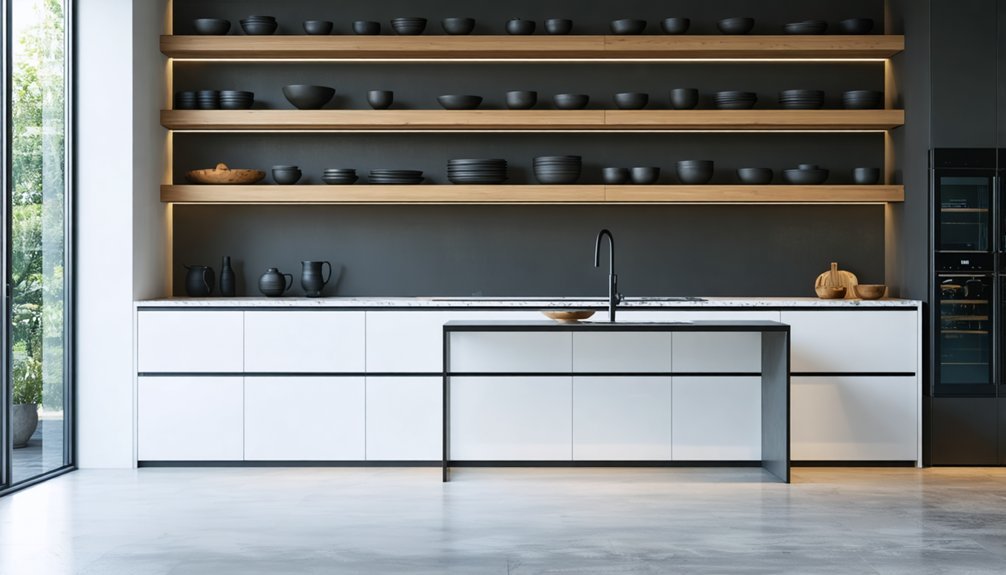
Modern kitchens in 2025 balance open shelving's minimalist appeal with clever hidden storage solutions. You'll find sleek floating shelves displaying carefully curated items like artisanal ceramics and everyday essentials, while keeping countertops clutter-free.
Smart storage innovations include pull-out pantries, drawer-within-drawer systems, and touch-activated cabinet doors that seamlessly blend into walls. You can maximize corner spaces with rotating carousel units and transform unused toe-kick areas into slim drawers for baking sheets. Magnetic knife strips and under-shelf hanging systems make use of vertical space without compromising the clean aesthetic.
The key is creating a show-worthy display area while tucking away bulk items and appliances. This dual approach lets you maintain the minimalist look you want while ensuring everything has its designated, hidden home.
Biophilic Elements and Natural Light Integration
Natural elements and abundant daylight define 2025's kitchen designs, bringing the outdoors inside through strategically placed windows, skylights, and glass doors. You'll find kitchens transformed into vibrant spaces where natural light streams through UV-protected glass, nurturing indoor herbs and creating an energizing atmosphere for cooking and gathering.
- Living walls filled with edible herbs and microgreens double as functional décor
- Light tubes and solar tunnels redirect sunlight into previously dark corners
- Bamboo and reclaimed wood elements add warmth and sustainability
- Smart glass windows automatically adjust tint based on sunlight intensity
Multi-Functional Islands and Flexible Workspaces
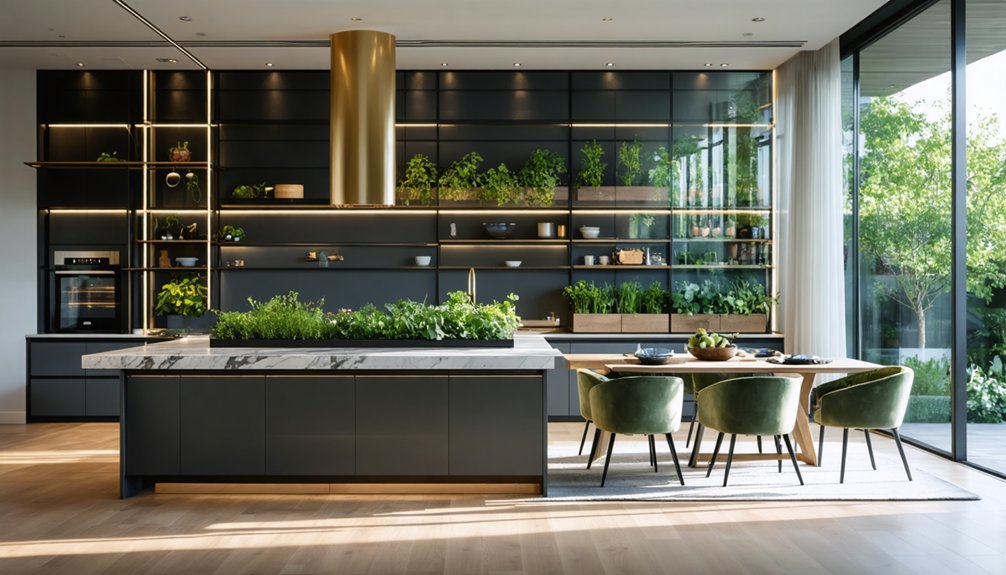
Today's kitchen islands have evolved far beyond basic prep stations into dynamic command centers that adapt to your changing needs. You'll find islands featuring retractable tables, built-in charging stations, and adjustable-height surfaces that transform from cooking zones to remote work desks.
The latest designs incorporate pull-out cutting boards, concealed appliance garages, and pop-up power outlets. You can maximize your island's functionality with modular components like removable butcher blocks, slide-out beverage stations, and hidden storage compartments. Smart technology integration lets you control lighting, temperature, and appliances right from your island hub.
Consider adding multi-level surfaces to create distinct zones for meal prep, dining, and workspace – perfect for families juggling remote work and homework while preparing meals.
Bold Color Palettes and Statement Surfaces
Breaking away from neutral-dominated spaces, 2025's kitchens embrace dramatic color combinations and eye-catching surface materials. You'll see rich jewel tones paired with metallic finishes, and bold patterns making their way onto countertops, backsplashes, and cabinet faces. The latest designs feature high-contrast color schemes that create visual interest while maintaining a sophisticated look.
- Deep emerald green and navy blue cabinets paired with brass or copper hardware
- Geometric-patterned quartzite and porcelain surfaces with dramatic veining
- Color-blocked walls and two-toned cabinet arrangements
- Textured glass backsplashes with iridescent or metallic finishes
Don't be afraid to mix materials and colors – the key is creating intentional contrast. Consider incorporating statement pieces like a vibrant range hood or uniquely patterned island countertop to serve as your kitchen's focal point.
Touchless Technology and Voice-Activated Features
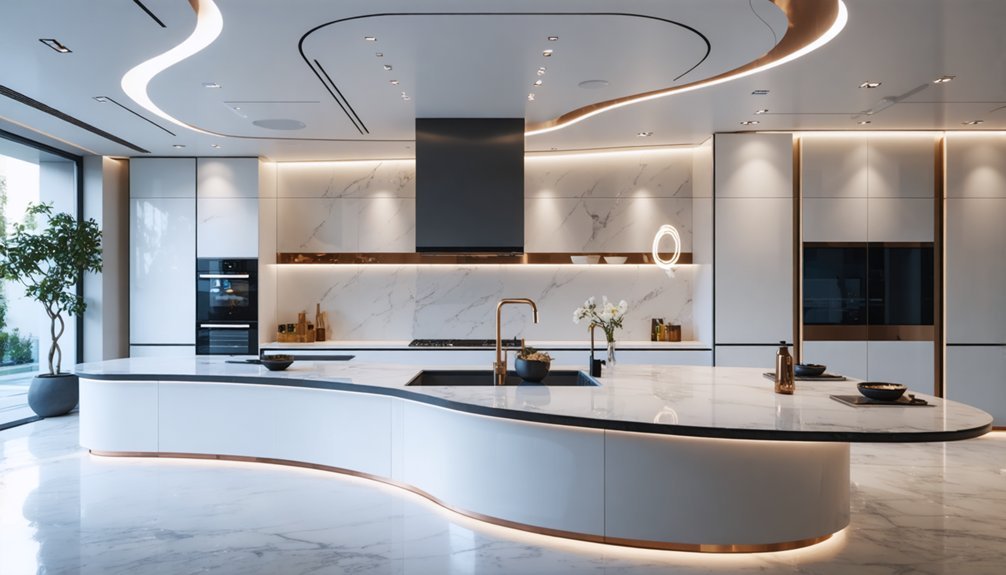
While bold aesthetics make a visual impact, modern kitchens in 2025 will focus heavily on hands-free functionality. You'll find voice-activated appliances and touchless features becoming standard elements in kitchen design, making cooking and cleaning more hygienic and efficient.
Feature Benefits Cost Range Voice Faucets Precise water control, germ reduction $300-800 Smart Refrigerators Inventory tracking, recipe suggestions $2000-5000 Motion Sensors Automatic cabinet opening, LED activation $150-400 Virtual Assistants Temperature control, timer management $200-600 These smart innovations won't just add convenience—they'll transform how you interact with your kitchen space. From adjusting lighting to controlling appliances, you'll command your kitchen through simple voice prompts or hand gestures, creating a more seamless cooking experience.
Conclusion
You'll find these 2025 kitchen trends blend cutting-edge technology with sustainable living and personalized style. Whether you're planning a complete overhaul or simple updates, incorporating smart appliances, eco-friendly materials, and flexible spaces will create a kitchen that's both functional and forward-thinking. By embracing these design elements, you're not just following trends – you're investing in a space that'll evolve with your needs.
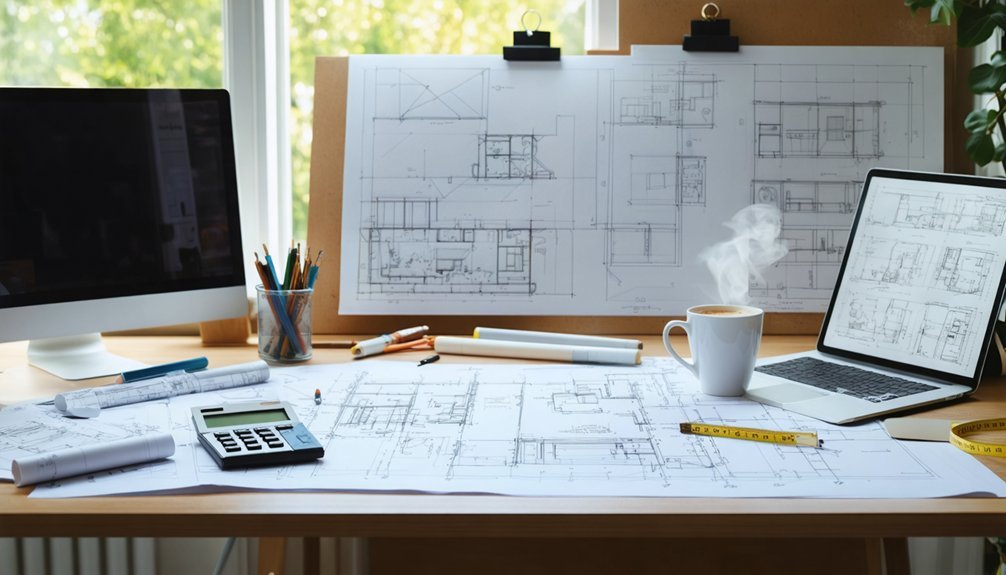
Complete Guide to Planning Your 2025 Home Remodel
Your 2025 home remodel should blend cutting-edge design with smart technology and sustainability. Start by creating a detailed budget that includes a 20% buffer for unexpected costs, then map out a realistic timeline with key milestones. You'll want to integrate energy-efficient features like smart windows and automated systems while incorporating biophilic elements. With proper planning and the right contractors, you'll transform your space into a future-ready haven that maximizes both function and value.
Key Home Design Trends and Innovations for 2025
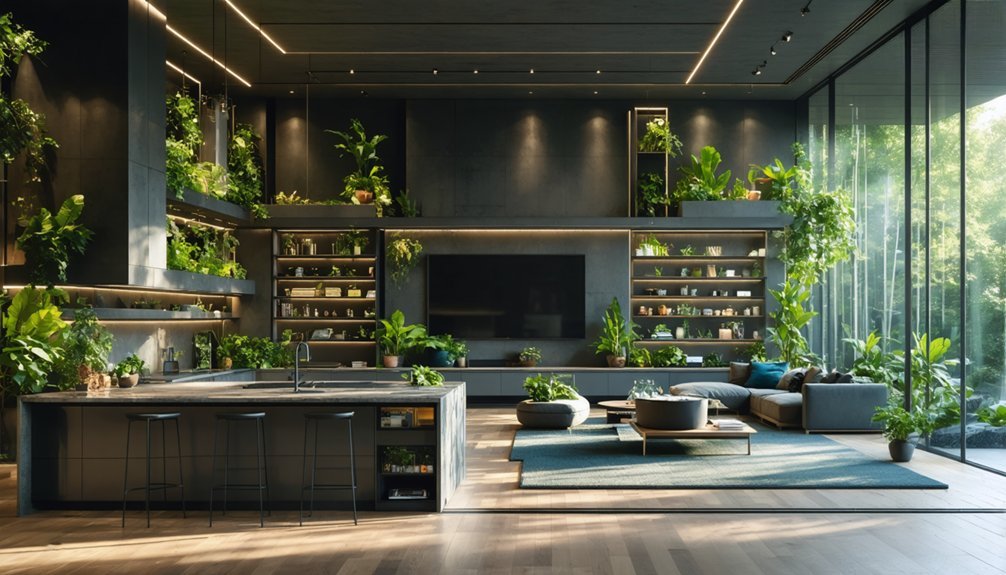
As homeowners increasingly prioritize functionality and sustainability, the design trends for 2025 reflect a blend of technological innovation and environmental consciousness. You'll see smart windows that automatically adjust tint based on sunlight, and energy-efficient appliances integrated with home automation systems. Sustainable materials like bamboo flooring and recycled composites are gaining popularity.
Open-concept layouts continue evolving with flexible spaces that transform from home offices to entertainment areas. Biophilic design elements incorporate living walls and indoor gardens, while voice-activated fixtures and touchless technology enhance daily routines. Color trends favor earth tones and natural textures, complemented by bold accent pieces.
Modern kitchens showcase multifunctional islands with built-in charging stations and hidden storage solutions. Bathroom designs emphasize spa-like features with water-saving fixtures and smart mirrors displaying health metrics.
Creating Your Budget and Financial Strategy
While these exciting design trends can inspire your renovation vision, establishing a realistic budget sets the foundation for your entire remodel project. Start by researching current material and labor costs in your area, then add a 20% buffer for unexpected expenses. You'll need to determine your funding source – whether it's savings, a home equity loan, or a renovation mortgage.
Break down your budget into major categories: structural work, materials, labor, permits, and design fees. Don't forget to factor in temporary housing costs if you'll need to relocate during construction. Create a detailed spreadsheet to track expenses and get multiple contractor bids to compare prices. Consider phasing your project if the total cost exceeds your current budget – you can tackle high-priority renovations first and space out other updates over time.
Essential Timeline and Project Planning Steps
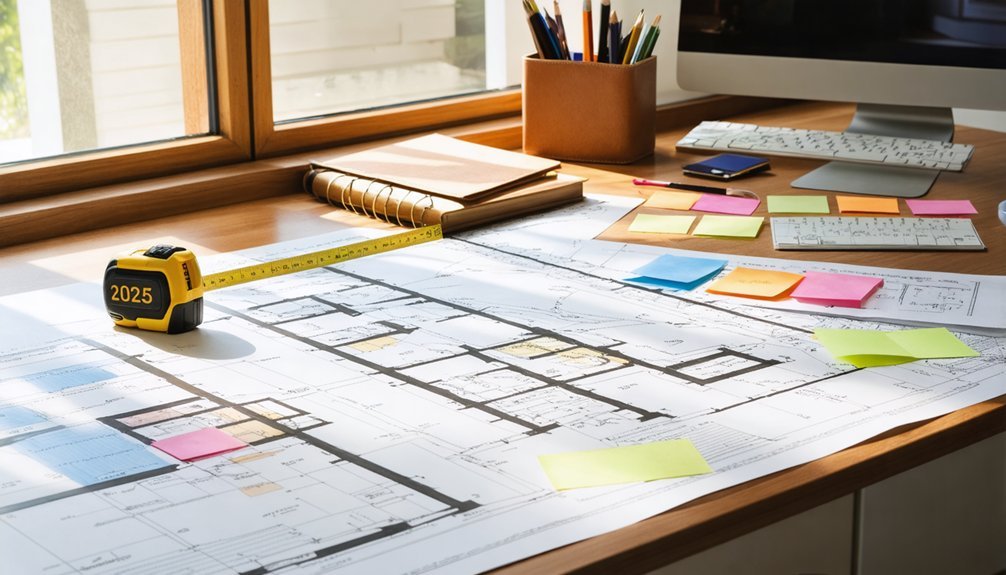
Once you've established your budget, creating a detailed project timeline becomes essential for keeping your remodel on track. Start by mapping out key milestones, including permit applications, contractor selection, material ordering, and construction phases.
Set realistic start and completion dates, factoring in potential delays due to weather, material availability, or contractor schedules. You'll need to allow 2-3 weeks for permit approvals, 3-4 weeks for contractor bidding and selection, and 1-2 weeks for material procurement. Break down each phase into specific tasks with clear deadlines.
Create a contingency buffer of 10-15% additional time to account for unexpected issues. Use project management tools or apps to track progress, coordinate with contractors, and maintain clear communication channels throughout your remodel timeline.
Selecting the Right Contractors and Materials
The success of your remodel hinges on choosing qualified contractors and high-quality materials. When vetting contractors, request multiple bids, check their licenses, and ask for references from recent projects. You'll want to verify their insurance coverage and ascertain they're experienced with your specific type of renovation.
For materials, prioritize quality over immediate cost savings, as superior products often prove more cost-effective in the long run. Here's what to look for in potential contractors:
- Licensed and insured with verifiable credentials
- Strong portfolio of similar projects
- Clear communication and detailed written estimates
- Positive reviews and references from past clients
Don't forget to research material suppliers, compare prices across multiple vendors, and consider the warranty terms for both labor and products. Request samples whenever possible to make sure you're getting exactly what you want.
Smart Home Technology and Sustainable Solutions
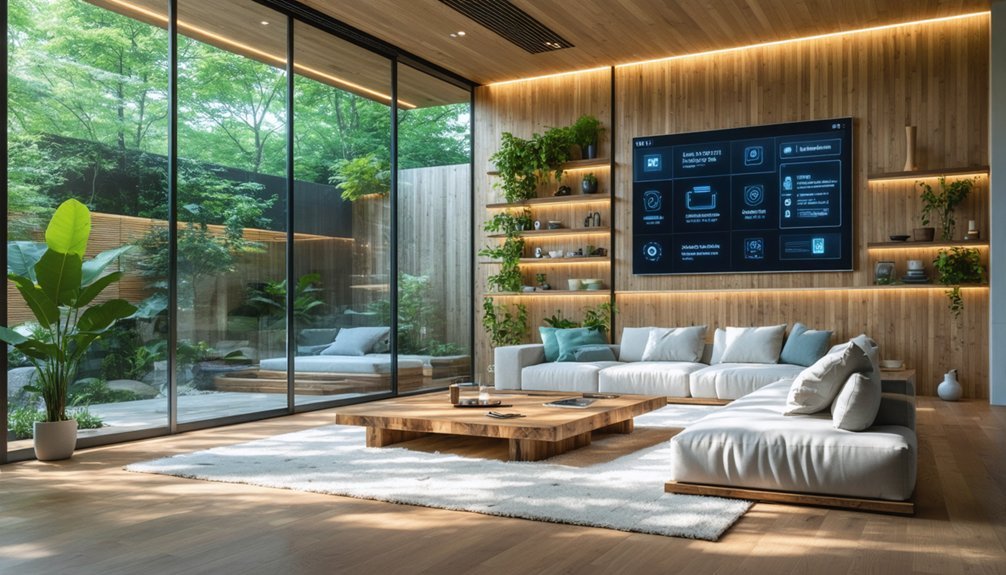
Modern remodeling projects increasingly embrace smart home technology and eco-friendly solutions to boost efficiency and reduce environmental impact. You'll want to contemplate integrating smart thermostats, LED lighting systems, and automated window treatments that learn your preferences while cutting energy costs. Solar panels and energy-efficient appliances offer long-term savings and sustainability benefits.
Technology Benefits Cost Range Smart Thermostat 10-15% energy savings $150-$300 LED Lighting 75% less energy use $200-$800 Solar Panels 40-70% power reduction $15K-$25K Smart Appliances 30% efficiency boost $2K-$8K Home Battery Backup power storage $8K-$15K Remember to choose systems that work together through a central hub, making your home both efficient and convenient to control from your smartphone or voice commands.
Conclusion
You're now equipped to tackle your 2025 home remodel with confidence. By staying on top of design trends, setting a realistic budget, creating a detailed timeline, choosing qualified contractors, and incorporating smart technology, you'll transform your space into a modern, sustainable haven. Don't forget to remain flexible throughout the process – even the best-laid plans may need adjustments. Start your planning today to guarantee a successful renovation tomorrow.
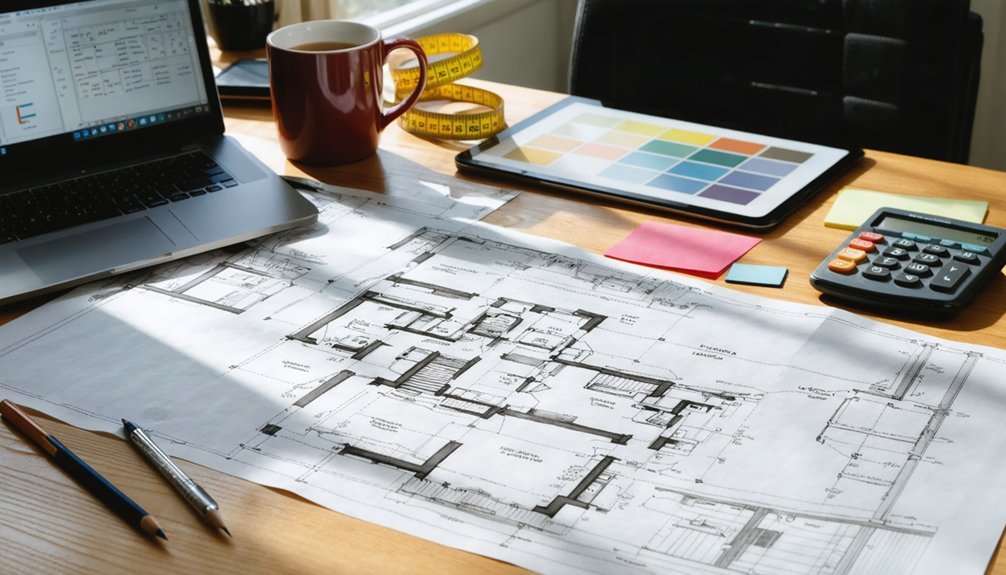
How to Plan Your Home Renovation in 10 Simple Steps (2025 Guide)
Start your home renovation journey by defining clear goals and creating a realistic budget with a 20% buffer for surprises. Research current design trends and materials while vetting qualified contractors through references and portfolios. Establish a detailed timeline, set up communication channels, and create a digital folder for tracking documents and progress. Don't forget to plan for temporary living arrangements during construction. Follow these expert steps to transform your space with confidence and peace of mind.
Define Your Renovation Goals and Vision

Before diving into any renovation project, you'll need to establish clear goals and create a detailed vision for your home's transformation. Start by identifying what's not working in your current space – whether it's outdated fixtures, poor functionality, or limited storage. Reflect on how you want to use each room and what specific improvements will enhance your daily life.
Write down your must-haves and nice-to-haves, then prioritize them based on importance and budget. Think about your home's style and how your planned changes will complement its existing architecture. Don't forget to contemplate long-term factors like resale value and energy efficiency. Take inspiration from design magazines, social media, and home improvement shows, but make sure your vision aligns with your practical needs and lifestyle.
Set a Realistic Budget and Financial Plan
While dreaming up renovation plans is exciting, establishing a detailed budget is crucial for project success. You'll need to research costs, get multiple contractor quotes, and add a 20% buffer for unexpected expenses. Break down your budget into clear categories and determine if you'll use savings, loans, or both to fund the project.
Expense Category Typical % of Budget Labor Costs 30-35% Materials 30-35% Fixtures/Finishes 15-20% Permits/Fees 5-10% Emergency Buffer 20% Track every expense in a spreadsheet and regularly compare actual costs against your estimates. If you're seeking financing, compare interest rates from multiple lenders and understand their terms. Remember that higher-quality materials may cost more upfront but could save money long-term through increased durability and energy efficiency.
Research Current Design Trends and Materials

Smart renovation planning requires staying current with design trends and material innovations that can enhance your home's value and functionality. Browse design magazines, follow home improvement influencers, and visit showrooms to identify styles that match your aesthetic while maintaining broad appeal.
Pay attention to sustainable materials, energy-efficient options, and smart home technology that'll add long-term value. You'll want to research both trending finishes like matte black fixtures or large-format tiles, and timeless elements that won't quickly become dated. Consider durability ratings, maintenance requirements, and real-world reviews of materials you're interested in using.
Create a digital mood board of your favorite design elements and material choices. This visual guide will help you communicate your vision to contractors and guarantee cohesive style throughout your renovation.
Create a Detailed Project Timeline
A well-structured timeline serves as the backbone of any successful renovation project. You'll need to break down your renovation into distinct phases, considering the logical sequence of tasks and potential dependencies. Start by working backward from your desired completion date, factoring in realistic timeframes for each stage of work.
Key phases to include in your timeline:
- Pre-construction (2-3 weeks): Finalizing designs, obtaining permits, and selecting contractors
- Demolition and structural work (1-2 weeks): Removing old fixtures, walls, and preparing the space
- Major installations (3-4 weeks): Plumbing, electrical, flooring, and cabinetry
Remember to build in buffer time for unexpected delays, material delivery times, and contractor availability. Keep your timeline flexible but structured, and communicate it clearly with all involved parties to guarantee everyone stays aligned with project goals.
Choose and Vet Professional Contractors

With your timeline established, selecting the right contractors becomes your next major step. Start by gathering recommendations from friends, family, and online review platforms. Create a shortlist of at least three contractors and request detailed bids from each.
When vetting contractors, verify their licenses, insurance coverage, and professional certifications. Don't hesitate to ask for references from recent clients and photos of completed projects. Schedule face-to-face meetings to discuss your renovation plans and assess their communication style and professionalism.
Pay attention to red flags like unusually low bids, pressure tactics, or reluctance to provide documentation. Once you've chosen a contractor, make certain all project details, including materials, costs, and timelines, are clearly outlined in a written contract before work begins.
Obtain Necessary Permits and Approvals
Before breaking ground on your renovation project, securing the proper permits and approvals from local authorities is essential. Contact your city's building department to learn which permits you'll need and what documentation they require. While smaller cosmetic changes might not need permits, most structural, electrical, or plumbing work will require official approval.
- Picture yourself facing hefty fines and having to redo completed work because you skipped the permit process
- Imagine discovering your insurance won't cover damage because you didn't obtain proper permits
- Visualize the struggle of selling your home later when buyers discover unpermitted renovations
Don't rely solely on your contractor to handle permits – you're ultimately responsible for compliance. Schedule inspections at key project phases and keep all documentation in a dedicated folder for future reference.
Develop a Room-by-Room Action Plan
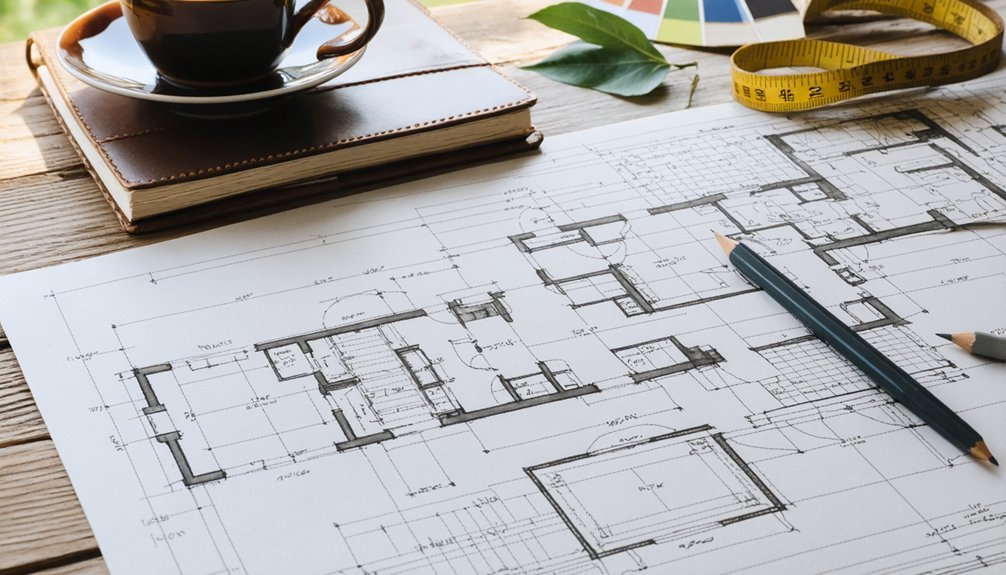
Once you've secured permits, creating a detailed room-by-room action plan will keep your renovation organized and efficient. Start by listing every space you'll renovate and break down each room's requirements into specific tasks. Include details like demolition, electrical work, plumbing, flooring, painting, and fixtures.
Prioritize rooms based on both functionality and budget constraints. Consider which spaces need immediate attention and which can wait. You'll want to tackle bathrooms and kitchens first if they're essential to daily living. Map out the sequence of work to minimize disruption and avoid damaging completed areas. Create a timeline for each room, factoring in material delivery dates, contractor availability, and drying times. Don't forget to plan temporary living arrangements if you'll need to relocate during specific phases.
Plan for Temporary Living Arrangements
Since major renovations can disrupt daily routines, you'll need to create a livable temporary space during construction. Consider whether you'll stay in your home or relocate temporarily based on the renovation's scope and duration. If you're staying, set up a functional living area away from the construction zone with essential items and appliances.
- Create a makeshift kitchen in your garage with a microwave, mini-fridge, and portable cooktop
- Set up a cozy bedroom in your finished basement or home office with proper ventilation and privacy curtains
- Designate a clean bathroom that won't be affected by construction dust and debris
If you decide to move out, factor temporary housing costs into your budget and research short-term rentals, extended-stay hotels, or staying with family members. Don't forget to arrange secure storage for furniture and valuables during the renovation.
Establish a Communication Strategy

Having a temporary living arrangement in place sets the stage for the next key element: clear communication channels with your renovation team. You'll need to establish specific methods for staying updated and addressing concerns throughout the project.
Communication Method Purpose Weekly Site Meetings Review progress and discuss upcoming work phases Group Chat App Quick updates and daily communication Shared Cloud Drive Store documents, permits, and design files Emergency Contact List Handle urgent issues or after-hours problems Set up these channels before construction begins and make certain everyone knows their preferred contact methods. You'll want to designate a primary point of contact for both your household and the contractor's team. This prevents miscommunication and guarantees you're always in the loop about your renovation's progress.
Document and Track Project Progress
While your renovation team handles the physical work, maintaining detailed records of the project's evolution is equally essential. Create a digital folder to store photos, receipts, contracts, and change orders. Take daily progress photos and maintain a project journal to document key decisions, challenges, and solutions.
Use a project management app or spreadsheet to track:
- Completed milestones – from demolition and framing to electrical work and finishing touches
- Budget updates – including approved changes, unexpected costs, and remaining funds
- Timeline adjustments – noting weather delays, material deliveries, and inspection schedules
Keep all communication records with contractors, designers, and suppliers in one place. This documentation will prove invaluable for future reference, warranty claims, and potential resale value discussions.
Conclusion
By following these 10 steps, you'll transform your renovation from an intimidating project into a manageable, well-organized endeavor. Remember to stay flexible as unexpected challenges may arise. Keep your goals, budget, and timeline in focus while maintaining clear communication with your contractors. When you plan thoroughly and stay organized, you'll be better equipped to create the home of your dreams.